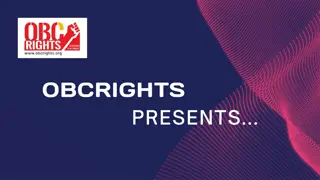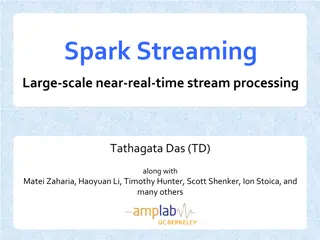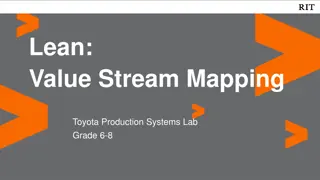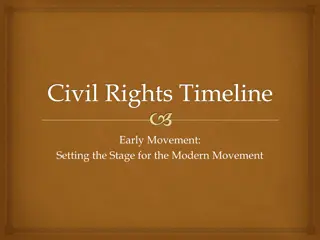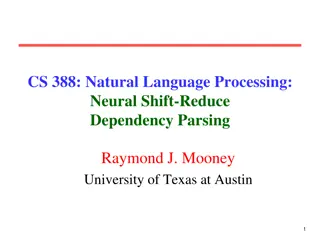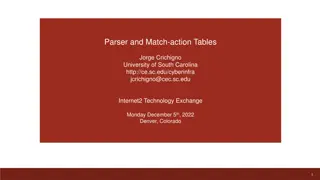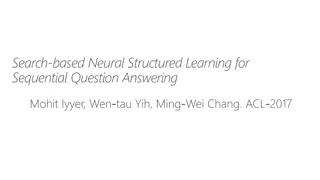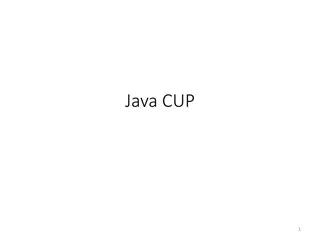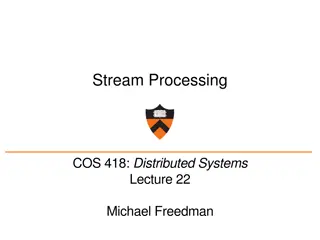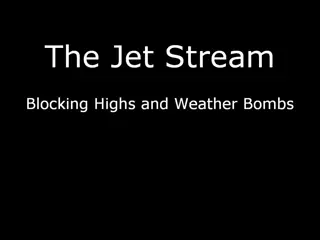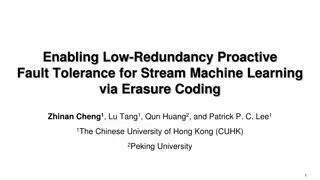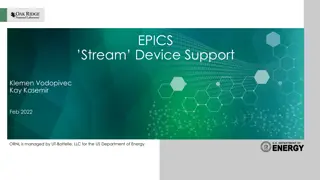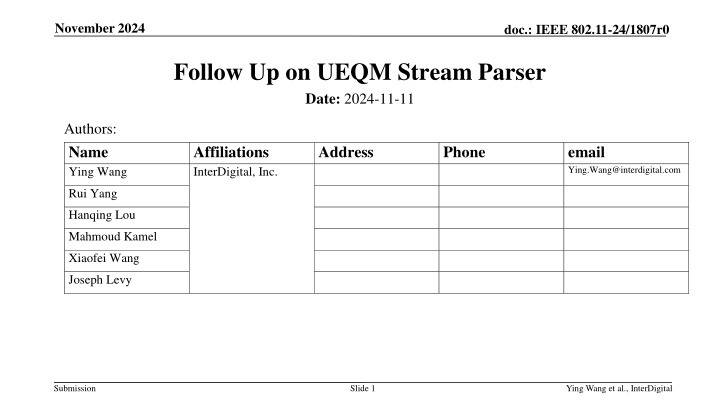
IEEE 802.11-24/1807r0 Follow-Up on UEQM Stream Parser in November 2024
"Learn about the enhancements to the stream parser for IEEE 802.11n with a focus on supporting BPSK-modulated streams in the context of UEQM. The proposal suggests solutions for parsing BPSK streams and considerations for bit allocation. Explore these advancements in the November 2024 documentation by InterDigital."
Download Presentation

Please find below an Image/Link to download the presentation.
The content on the website is provided AS IS for your information and personal use only. It may not be sold, licensed, or shared on other websites without obtaining consent from the author. If you encounter any issues during the download, it is possible that the publisher has removed the file from their server.
You are allowed to download the files provided on this website for personal or commercial use, subject to the condition that they are used lawfully. All files are the property of their respective owners.
The content on the website is provided AS IS for your information and personal use only. It may not be sold, licensed, or shared on other websites without obtaining consent from the author.
E N D
Presentation Transcript
November 2024 doc.: IEEE 802.11-24/1807r0 Follow Up on UEQM Stream Parser Date: 2024-11-11 Authors: Name Ying Wang Affiliations InterDigital, Inc. Address Phone email Ying.Wang@interdigital.com Rui Yang Hanqing Lou Mahmoud Kamel Xiaofei Wang Joseph Levy Submission Slide 1 Ying Wang et al., InterDigital
November 2024 doc.: IEEE 802.11-24/1807r0 Introduction Unequal modulation (UEQM) is accepted as a feature for 11bn TGbn SFD [1] TGbn defines unequal modulation over different spatial streams. UHR defines unequal modulation only for LDPC. A unified stream parser that supports both EQM/UEQM is preferred The authors propose to reuse the stream parser formulas used for 802.11n with some small changes in 802.11bn [2] Some concerns have been expressed regarding the 802.11n stream parser not being able to handle BPSK in UEQM streams Submission Slide 2 Ying Wang et al., InterDigital
November 2024 doc.: IEEE 802.11-24/1807r0 Brief Recap on the 802.11n Stream Parser In each round of bit allocation, spatial stream ???gets the number of bits assigned to a single axis (real or imaginary) in its corresponding constellation point This leads to a problem if any spatial stream is BPSK-modulated BPSK needs only 1 round to get the bits for a constellation point while QPSK and higher modulations need 2 rounds Submission Slide 3 Ying Wang et al., InterDigital
November 2024 doc.: IEEE 802.11-24/1807r0 UEQM Stream Parser With BPSK In this contribution, three UEQM stream parsers that can parse BPSK streams are proposed 11n stream parser with a new bit allocation unit size 11n stream parser with leftover bits 11n stream parser with skipped rounds for BPSK Given these possible solutions, agreement should be reached on if BPSK stream parsing should be supported If no, 11n stream parser should be reused If yes, a stream parser that supports BPSK stream parsing should be chosen Submission Slide 4 Ying Wang et al., InterDigital
November 2024 doc.: IEEE 802.11-24/1807r0 Option 1: New Bit Allocation Unit Size (1) Let the number of bits allocated in each round to a spatial stream be the number of bits mapped to its corresponding constellation point ????????? instead of ? ??? = max(1,??????(???)/2) Submission Slide 5 Ying Wang et al., InterDigital
November 2024 doc.: IEEE 802.11-24/1807r0 Option 1: New Bit Allocation Unit Size (2) Bit ? of the input bit sequence ?? is assigned to bit ? of the output bit sequence ??,???at spatial stream ???, where ? is a function of ??? and ?, and the mapping function can be expressed as ??,???= ?? ??? 1 ? ??????,?+ ? mod ??????,??? ? = ? + ??????,??? ?=0 ??? 1??????,??? ???= 0,1, ,??? 1,? = 0,1, ,????? 1, and ? = 0,1, ,??????,??? 1. ? = ???=0 Submission Slide 6 Ying Wang et al., InterDigital
November 2024 doc.: IEEE 802.11-24/1807r0 Option 2: Leftover Bits (1) ???= 0 BPSK ?0 ?0 Leftover bits ?0 ?0 ??,0,? = 0,1, ,??????,0 1 ? ? ???= 1 Stream Parser ?1 ?1 ?1 ?1 ?1 ?1 ?1 ?1 ?2 ?0 ?1 ?2 ?0 ?1 ?2 ?1 ?2 ??,? = 0,1, ,????? 1 ??,1,? = 0,1, ,??????,1 1 ???= 2 ?2 ?2 ?2 ?2 ?2 ?2 ?2 ??,2,? = 0,1, ,??????,2 1 Keep the number of bits allocated in each round to spatial streamsstill as? ??? = max(1,??????(???)/2) The BPSK stream(s) uses half number of total rounds to obtain all its bits while the higher modulation streams continue to draw from remaining leftover bits in a round-robin fashion until all the bits are allocated Submission Slide 7 Ying Wang et al., InterDigital
November 2024 doc.: IEEE 802.11-24/1807r0 Option 2: Leftover Bits (2) Bit ? of the input bit sequence ?? is assigned to bit ? of the output bit sequence ??,???at spatial stream ???, where ? is a function of ??? and ?, and the mapping function can be expressed as ??,???= ?? ??? 1 ? ? ??+ ? mod ????,if ? + < ??? ???? ???? ?=0 ? = ??? 1 ? ? ?? ?(??????,???> 1) + ? mod ????,if ??? ? ???+ ? + < 2??? ???? ???? ?=0 ??? 1????. ? = ???=0 ??? 1???? ?(??????,???> 1), ???= 0,1, ,??? 1,? = 0,1, ,????? 1, and ? = 0,1, ,??????,??? 1.? = ???=0 ???= ??????,???/??????,??? is the number of effective data tones carrying unique data per symbol, ? = ? ???? ???, and ?(??????,???> 1) is an indicator function of whether the modulation order on spatial stream ??? is larger than BPSK or not; ?(??????,???> 1) equals to 1 when ??????,???> 1 is true, i.e., the modulation order is higher than BPSK, and 0 otherwise. Submission Slide 8 Ying Wang et al., InterDigital
November 2024 doc.: IEEE 802.11-24/1807r0 Option 3: Skipping Rounds for BPSK (1) ???= 0 ? BPSK ?0 ?0 ?0 ?0 ?0 ?0 ??,0,? = 0,1, ,??????,0 1 ? ???= 1 Stream Parser ?1 ?1 ?1 ?1 ?1 ?1 ?0 ?1 ?2 ?1 ?2 ?0 ?1 ?2 ?1 ?2 ?0 ?1 ?2 ?1 ?2 ??,? = 0,1, ,????? 1 ??,1,? = 0,1, ,??????,1 1 ???= 2 ?2 ?2 ?2 ?2 ?2 ?2 ??,2,? = 0,1, ,??????,2 1 Let the number of bits allocated to a spatial stream in even round be the number of bits assigned to the real axis in its corresponding constellation point, and in odd round be the number of bits assigned to the imaginary axis BPSK: 1 bit in even rounds, 0 bit in odd rounds QPSK or higher: ? ??? = ??????(???)/2 for both even and odd rounds Submission Slide 9 Ying Wang et al., InterDigital
November 2024 doc.: IEEE 802.11-24/1807r0 Option 3: Skipping Rounds for BPSK (2) Bit ? of the input bit sequence ?? is assigned to bit ? of the output bit sequence ??,???at spatial stream ???, where ? is a function of ??? and ?, and the mapping function can be expressed as ??,???= ?? ??? 1 ? ? ??+ ? mod ????,if (? mod ??????,???) < ???? + ??????,??? ?=0 ? = ??? 1 ? ? ?? ? ??????,???> 1 + ? mod ????,if (? mod ??????,???) ???? + ? + ??????,??? ?=0 ??? 1????. ? = ???=0 ??? 1??????,???, ???= 0,1, ,??? 1,? = 0,1, ,????? 1, and ? = 0,1, ,??????,??? 1.? = ???=0 ?(??????,???> 1) is an indicator function of whether the modulation order on spatial stream ??? is larger than BPSK or not; ?(??????,???> 1) equals to 1 when ??????,???> 1 is true, i.e., the modulation order is higher than BPSK, and 0 otherwise. Submission Slide 10 Ying Wang et al., InterDigital
November 2024 doc.: IEEE 802.11-24/1807r0 Summary To decide if BPSK is allowed in UEQM streams Stream parser options provide members a consideration point when making decisions Further throughput performance simulations may be needed to compare the effect of including or excluding BPSK in UEQM streams Three options are proposed for stream parser to handle UEQM with BPSK All options are unified stream parser that can handle both EQM and UEQM with/without BPSK Option 1 has the least complexity, but has a coarser bit allocation unit, meaning more consecutive bits clustered on the same tone/stream Option 2 and 3 have about the same slightly higher complexity, and Option 3 is better in terms of evenly spreading bits across tones and streams Option 3 is preferred Submission Slide 11 Ying Wang et al., InterDigital
November 2024 doc.: IEEE 802.11-24/1807r0 References 1. IEEE 802.11-24/0209r4, Specification Framework for TGbn, July 2024. 2. IEEE 802.11-24/1451r2, UEQM Transmission Over Spatial Streams, September 2024. Submission Slide 12 Ying Wang et al., InterDigital
November 2024 doc.: IEEE 802.11-24/1807r0 SP #1 Do you agree that the 11bn stream parser should support BPSK in UEQM spatial streams? Yes No Need further study Abstain Submission Slide 13 Ying Wang et al., InterDigital
November 2024 doc.: IEEE 802.11-24/1807r0 SP #2 Assuming BPSK is supported for UEQM spatial streams in 11bn, which options do you prefer for the stream parser (multiple choices): 1) New Bit Allocation Unit Size, as described in 11-24/1807r0 2) Leftover Bits, as described in 11-24/1807r0 3) Skipping Rounds for BPSK, as described in 11-24/1807r0 4) Others Submission Slide 14 Ying Wang et al., InterDigital



